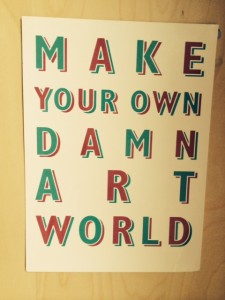Last week I went to hear Henry Kippin of Collaborate talk about their new publication Building Collaborative Places: Infrastructure
for System Change, at a meeting of North East Together, The Leaders Network for Social Change. The paper
argues that in a time of ‘permanent austerity as the new norm, not a passing
correction’ as Henry put it, places will need to think more about whole-system collaboration if
the services and outcomes people want are to be sustained, be that in health,
business, social development or other areas. Two big questions for the cultural
sector: what role do you play in your local system (I wanted to ask whether
‘place’ could be pushed as far as metaphorical space such as ‘theatre’) and what
demand are you meeting? The nine elements of infrastructure for collaboration
set out could be adapted easily for most collaborations cultural organisations
or artists find themselves in.
The Museums Association is renewing its Museums Change Lives
campaign. This has a dual intent: encouraging museums to be socially useful and
letting funders and others know museums are socially useful. There are events
but the short publication gives a lot of interesting examples whilst framing a
key function of museums around ‘socially engaged practice’. There are also links
to resources. I found myself hooked on the sentence ‘They (museums) are not
neutral spaces.’ and wondering quite what that might mean in practice. Maybe it
depends on where museums sit in local systems?
One reason
why this needs to be thought about is captured in this blog by Dave O’Brien and
Mark Taylor, describing Brexit as a cultural phenomenon. Where does culture sit
in a system where few cultural workers know either a postman (their term,
gendered noun watchers) or a bank manager?
You can
have too much of a good thing such as collaboration, of course, especially if
it’s compensating for some bad things. This paper suggests internal
collaboration often reflects over-complex organisations, poor communication and
unclear, ineffective leadership that would rather invite everyone to a meeting
than deal well with tricky issues. Simplify and align is a common theme to many
discussion I have with people. I have also long given the advice in this
article to think of meeting time as a limited resource you can choose to invest
well or badly, and to know the cost of every meeting. Just looking around the
room to tot up the salaries of people involved in a regular meeting tends to
focus minds.
After my
long, neck-twisting look back and forward last week there seemed to be a slew
of challenging stats and reports that made me think I'd been a little
optimistic. One example is this, which illustrates the less-visible erosion
that is taking place behind the seemingly open doors of even the biggest institutions.
The trouble with erosion is it sneaks up on you….
An example
of two things: me being a bit over-optimistic and me worrying about acceptance
of the status quo and what Dave O’Brien and Mark Taylor might call ‘the social
closure of cultural production’.

Comments
Post a Comment